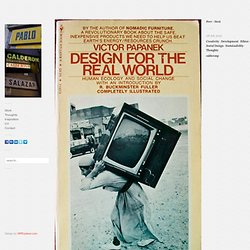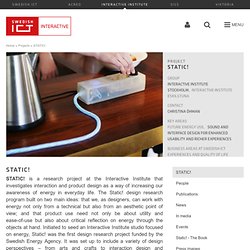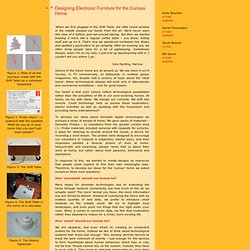

Excerpts of Papanek’s ‘Design for the Real World’ I am doing my second reading of Papanek’s Design for the Real World: Human Ecology and Social Change, simultaneous to my first steps on the research for my thesis project, which I will develop throughout the coming year (Sep 2012 – Jun 2013).

Here I will leave some quotes and notes on the book that I find interesting and/or relevant for my project. (PREFACE) There are professions more harmful than industrial design, but only a very few of them. Dunne & Raby deel 1. Haus.0. Tools/Supergas installation. Internet delle cose. Da Wikipedia, l'enciclopedia libera.

In telecomunicazioni Internet delle cose (o, più propriamente, Internet degli oggetti o IoT, acronimo dell'inglese Internet of Things) è un neologismo riferito all'estensione di Internet al mondo degli oggetti e dei luoghi concreti. Il suo primo utilizzo ebbe luogo probabilmente nel 1999[1] presso l'Auto-ID Center, un consorzio di ricerca con sede al MIT[2]. Il concetto fu in seguito sviluppato dall'agenzia di ricerca Gartner[3][4][5]. Descrizione[modifica | modifica wikitesto] L'Internet delle cose è vista come una possibile evoluzione dell'uso della Rete. L'obiettivo dell'internet delle cose è di far sì che il mondo elettronico tracci una mappa di quello reale, dando un'identità elettronica alle cose e ai luoghi dell'ambiente fisico. I campi di applicabilità sono molteplici: dalle applicazioni industriali (processi produttivi), alla logistica e all’infomobilità, fino all'efficienza energetica, all'assistenza remota e alla tutela ambientale.[9]
Research. Design and the Elastic Mind. STATIC! Static!

- The Book Announcing the first comprehensive book about the ground-breaking research project by the Interactive Institute! Mazé, Ramia (ed.) Static! Designing for Energy Awareness. Static! From the back cover In Static! Table of Contents Introduction p. 7 Strategic frames, Christina Öhman and Sara Backlund, p. 11 Research frames, Johan Redström, 15 Essay: ‘Current’ issues in sustainable design and research, Johan Redström, p. 21 Perspective: Critical practice, Ramia Mazé, p. 37 Perspective: People in design, Sara Ilstedt Hjelm, p. 43 Static!
The book was commissioned by the Interactive Institute, the Nordic Culture Fund and the Swedish Energy Agency. Order the book Purchase at arvinius.se, amazon.com, and other bookstores. Press release Ny bok från Interactive Institute: "Static! THE PRESENCE PROJECT. The big problem with information technology is that it tries so hard to be rational.

By contrast, humans are happy to be rational only part of the time. Most other times (apart from the fact that they sleep so much) people operate in very different modes: of daydreaming and pondering; of joy and melancholy; of hope and of despair – apart from all the other subliminal states of which, most of the time, we are not even aware. Now, all of these I would call the non-rational [...] Because all information technology systems have started out in life with a big ration of the rational, the logical conclusion seems to be that, indeed, we should work towards a new and perfect world – a technocracy directed by the empty ethos of machines. Projects under the i3 [Intelligent Information Interfaces] research initiative – and in particular Presence – rejected this purely positivistic absurdity, that along with the development of the computer, has been furiously promulgated over the last 50 years.
Designing Electronic Furniture for the Curious Home. Andy Boucher, Sarah Pennington, Jacob Beaver, Bill Gaver ‘When we first plugged in the Drift Table, the little round window in the middle showed our home from the air.

We’d never seen this view of it before, and sat around staring. But then we started treating it more like a regular coffee table – you know, letting stuff pile up on it. That’s how we wandered northwest into Wales and spotted a good place to go camping. After an evening out, we often bring people back for a bit of sightseeing. Julie Harding, Harrow Visions of the future home are all around us. Our belief is that such visions reflect technological possibilities rather than the actualities of life in our ever-evolving homes.